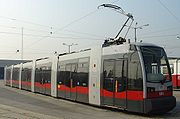Electric drive vehicle
 
|
||||
Electric vehicles around the world (from top left):
|
An electric vehicle (EV), also referred to as an electric drive vehicle, uses one or more electric motors or traction motors for propulsion. An electric vehicle may be powered through a collector system by electricity from off-vehicle sources, or may be self-contained with a battery, solar panels or a generator to convert fuel to electricity. EVs include road and rail vehicles, surface and underwater vessels, electric aircraft and electric spacecraft.
EVs first came into existence in the mid-19th century, when electricity was among the preferred methods for motor vehicle propulsion, providing a level of comfort and ease of operation that could not be achieved by the gasoline cars of the time. The internal combustion engine (ICE) has been the dominant propulsion method for motor vehicles for almost 100 years, but electric power has remained commonplace in other vehicle types, such as trains and smaller vehicles of all types.
In the 21st century, EVs saw a resurgence due to technological developments and an increased focus on renewable energy. Government incentives to increase adoptions were introduced, including in the United States and the European Union.
Electric motive power started in 1827, when Slovak-Hungarian priest Ányos Jedlik built the first crude but viable electric motor, provided with stator, rotor and commutator, and the year after he used it to power a tiny car. A few years later, in 1835, professor Sibrandus Stratingh of University of Groningen, the Netherlands, built a small scale electric car and a Robert Anderson of Scotland is reported to have made a crude electric carriage sometime between the years of 1832 and 1839. Around the same period, early experimental electrical cars were moving on rails, too. American blacksmith and inventor Thomas Davenport built a toy electric locomotive, powered by a primitive electric motor, in 1835. In 1838, a Scotsman named Robert Davidson built an electric locomotive that attained a speed of four miles per hour (6 km/h). In England a patent was granted in 1840 for the use of rails as conductors of electric current, and similar American patents were issued to Lilley and Colten in 1847.
...
Wikipedia








